
 |
Smale - Williams attractor |
Mathematical theory of chaos based on a rigorous mathematical approach deals with strange attractors of hyperbolic type. In such attractor all belonging orbits in phase space are of saddle type, and the invariant sets of trajectories approaching the original one in forward or backward time (stable and unstable manifolds) intersect transversally, i.e. without touch.
Unfortunately, most of known physical systems like simple chaotic generators, nonlinear oscillators with periodic driving etc. do not belong to the class of systems with hyperbolic attractors. Chaos in them is associated as arule with the so-called quasi-attractor, which contains together with chaotic trajectories also a set of stable orbits of large periods (not observable in computations because of extremely narrow domains of attraction).
Hyperbolic strange attractors are robust (structurally stable). It means non-sensitivity of character of motions and mutual disposition of orbits in the phase space in respect to variation of the equations of the system. In contrast with the hyperbolic attractors, the quasi-attractors manifest sensitive dependence of details of the dynamics on parameters. Obviously, it is not so good in potential applications of chaos, like secure communications, signal masking etc. Hence, both from the point of view of fundamental studies and of applications it would be interesting to find physical examples of the hyperbolic chaos.
In text-books on nonlinear dynamics examples of the hyperbolic attractors are represented by abstract constructions. For instance, the Smale - Williams attractor is constructed for a three-dimensional map defined by the following procedure. Let us consider a domain of toral form, stretch it twice and fold and embed into the original object as shown in the picture. At each next iteration a number of coil is doubled. The object forming in a limit of infinite iterations is called the Smale - Williams solenoid. The transversal structure of it is a Cantor-like set.

Introducing an angle coordinate q as shown in the picture, it is easy to see that under iterations of the Smale - Williams procedure it will be governed by a Bernoulli map map: qn+1={2qn}. Two rest directions correspond to contraction of the phase volume. Hence, an appropriate candidate for realization of the Smale - Williams attractor is a system of non-autonomous oscillators discussed on a page devoted to the Bernoulli map.
Let us turn to the following scheme [S.P.Kuznetsov, Y.P.Seleznev, JETP, 2006, No 2].

Each of two subsystems is a driven self-oscillator. It contains
an oscillatory circuit composed of an inductor L1,2 and a capacitor C1,2;
the characteristic frequency of the second contour is twice larger then that of the first one.
Negative resistance
To compose equations for the scheme we have to write down equations of Kirchhoff: a condition of vanishing summary current in parallel branches for each subsystem, and equations linking voltage and current for the inductor coils. After variable change transforming the equations to the dimensionless form, we get
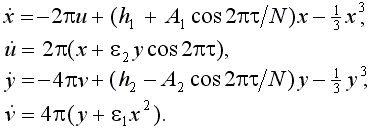
Here the normalized variables x and u characterize voltage and current in the LC contour of the first self-oscillator (U1 and I1, respectively); y and v are normalized voltage and current in the second contour (U2 and I2). Time is normalized by the period of oscillations of the first LC contour. Parameters A1 and A2 determine amplitude of slow modulation of the parameter responsible for the Andronov - Hopf bifurcation in both self-oscillators, and h1 and h2 determine a map of the mean value of this parameter from the bifurcation threshold. Finally, e1 and e2 are coupling parameters.
We can consider the dynamics stroboscopically, tracing
a discrete sequence of instantaneous states with period T.
It corresponds to iterations of some 4D map.
Indeed, an instantaneous state of the system
is determined by a set of four variables
The considered system has been constructed as a laboratory device, with characteristic frequencies of the LC circuits approximately equal to 1 and 2 kHz, respectively. The voltages U1 and U2, respectively, on the first and the second LC circuit, could be transferred to registration apparatus (oscilloscope, spectrum analyzer) or introduced into computer by means of the analog-digital transformer. Time derivative could be obtained as a result of analog signal transformation with a standard electronic differentiator containing a capacitor, a resistor, and an operational amplifier.
In experiment, with appropriately selected parameters it was easy to observe the chaotic oscillations due to the turn-by turn transfer of excitation from one subsystem to another. The picture shows typical plots of voltages versus time in a chaotic regime for a case of the period ratio N=4. The first plot is experimental, and the second is obtained from numerical solution of the equations.
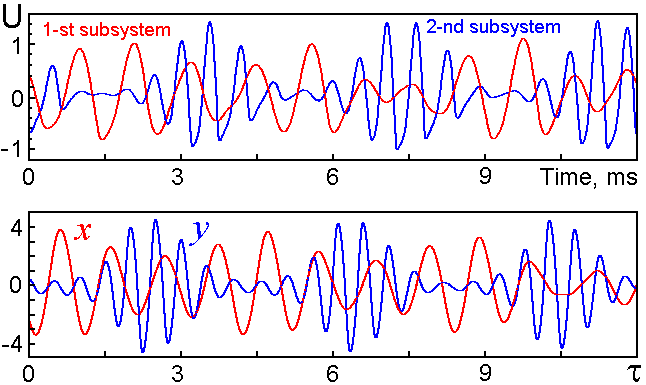
The next pair of diagrams shows attractor portraits in projection onto a plane of the first oscillator variable and its derivative. The color portrait was photographed directly from the oscilloscope screen. Another one is obtained from computer solution of the equations. It is represented in gray scales, where brightness of the image is proportional to a relative period of residence in the corresponding area.
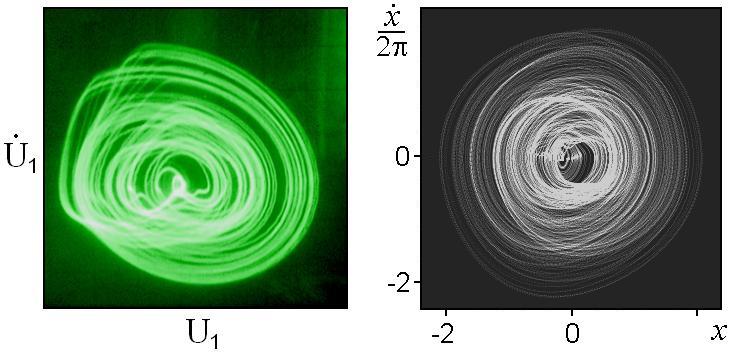
To resolve structure intrinsic to the Smale - Williams attractor we have to consider the attractor portrait in stroboscopic cross-section. There we plot points at each next period of the external driving T. The first diagram is obtained in experiment, and the second one from numerical solution of the equations. The portrait looks exactly as the Smale - Williams solenoid should look like. Observe presence of the transversal fractal-like structure.

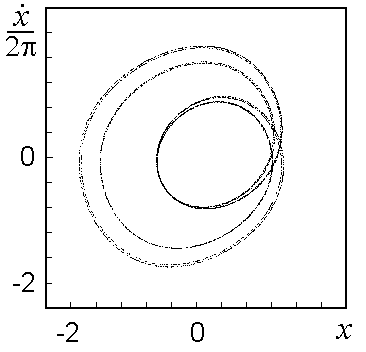
The last figure shows Fourier spectra generated by the first and the second oscillator. The top picture is obtained in experiment by photographing screen of the spectrum analyzer. The bottom one is built by processing of data of numerical solution of the equations. Observe evident continuous nature of the spectrum characteristic for the random processes, and absence of notable peaks and pits, which would be typical for spectra generated by quasiattractors.
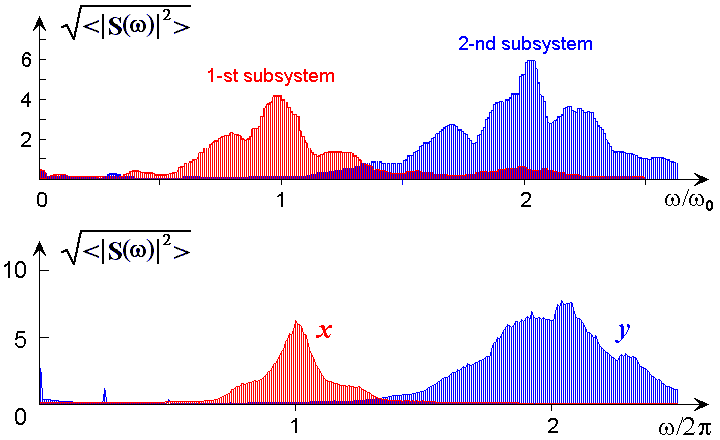
Resuming, on a basis of the present results we assert confidently that both in the experiment and in the theoretical model we deal with the same object, the attractor of Smale - Williams type in a non-autonomous oscillatory system.
Recently a mathematical foundation of the hyperbolic nature of the chaotic attractor in technique of computer assisted proof was published for the considered scheme of two alternately excited oscillators transmitting excitation each other. [Daniel Wilczak. Uniformly Hyperbolic Attractor of the Smale–Williams Type for a Poincare Map in the Kuznetsov System . SIAM J. Applied Dynamical Systems, 9, 2010, No. 4, 1263–1283] ( Preprint arXiv:1006.0614)
Appearance of an example of a physical system with hyperbolic chaotic attractor is of principal significance for future development of the nonlinear dynamics and its applications. This is in a sense a "breakthrough into a hyperbolic domain". Indeed, on a basis of the robustness (structural stability) of the hyperbolic attractor one can construct other examples of hyperbolic chaos by variation of the right-hand functions in the equations. Existence of the physical examples of hyperbolic chaos opens possibilities for applications of the well developed mathematical hyperbolic theory and opportunities of comparative studies of hyperbolic and non-hyperbolic chaos in theory and experiments.